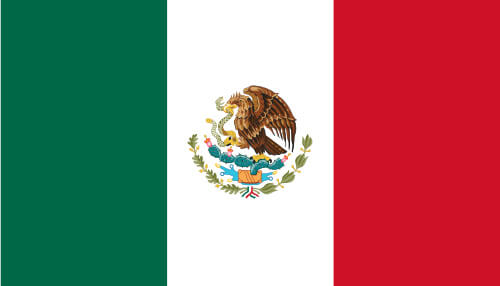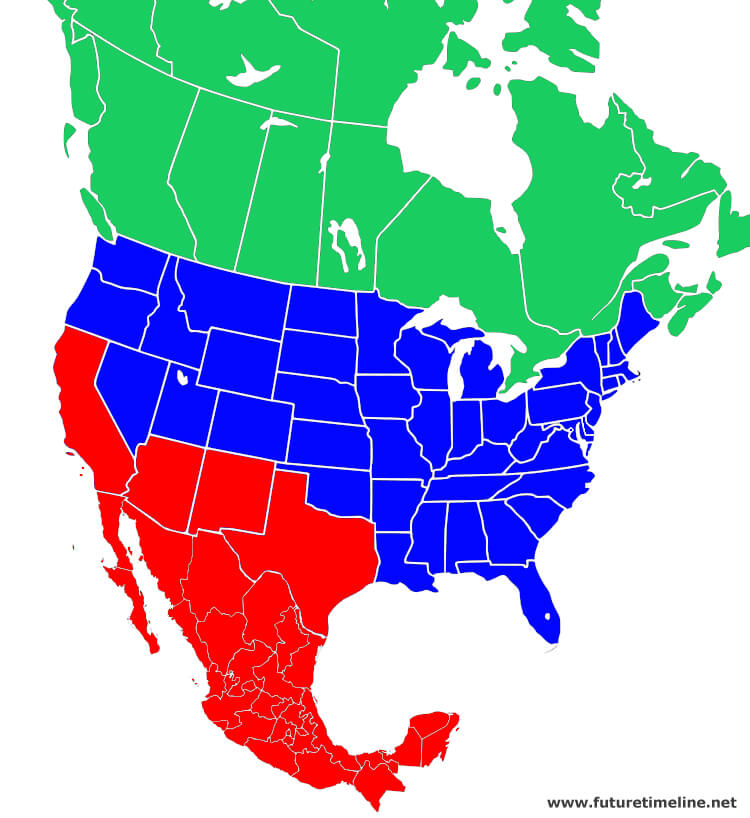For
over two centuries, the United States effectively controlled the entire
North American continent. Its dominance throughout this time was unquestioned.
During the late 21st century, however, its territorial integrity was being challenged once again. By the early 2080s, four of its fifty states had been ceded to Mexico.*
What led to this astonishing development?

Most historians would agree it began in the 2030s. America's shrinking labour supply during this time led to the introduction of laws encouraging a massive influx of immigrants. These came from all over the world – but a substantial portion came from Mexico due to its geographical proximity and strong cultural ties. Although many different ethnic groups would arrive, the Mexicans would behave differently. It was this, combined with Mexico's growing economic strength, that would lead to a slow but gradual shift in the balance of North American power.*
The various immigrant groups from around the world became culturally integrated with the USA. They fragmented and settled around the country, without overwhelming any region or state.
The immigrants from Mexico behaved differently, however. Many became integrated with the USA – but unlike the other groups, they would always be in close proximity to their homelands. With most settling in California, Arizona, Texas and New Mexico, they were never more than a short journey from the border. This fostered a growing intermingling of cultures in the southwestern states.
Over time, the social and economic links of the Mexican immigrants began to predominate, to such an extent that they almost represented an extension of their homeland into the United States. These lands had once been Mexican anyway – before the territory was taken by the US in the 19th century – so they already held many characteristics of Mexican society and culture. As the decades rolled by, with more and more immigrants pouring into the country, this influence shifted ever northward. By the middle of the century, states that had been 25% Mexican were now over 50% Mexican, while states which had been 50% Mexican were now almost entirely occupied by Mexicans.*
Climate change was now an added factor, driving large numbers from the southern parts of Mexico to head north, where food and water was more readily available.
This wave of immigration solved the labour supply issue, and contributed to a period of economic boom in the USA.
At the same time, however, a number of radical new technologies were in development: technologies that would lead to a socio-political crisis in later years. Chief amongst these was the growth of robotics. A range of highly versatile machines had already been in military use since the 2030s. These began spreading to consumer markets. By the 2060s, they were becoming sufficiently powerful, intelligent and numerous to make vast numbers of civilian jobs redundant.
This greatly reduced the need for immigration. Millions of workers were now permanently displaced, without the skills to move into robotics support or maintenance. Their previous roles were now being handled by machines that were not only cheaper, but also faster and more productive than any human. Manufacturing, mining, building and construction trades, mechanical work, maintenance and a host of other roles were being dominated by robots.

© Chrisharvey | Dreamstime.com
Unemployment began to soar, exacerbated by advances in longevity which meant that workers were now remaining active longer than ever before. This combination of increased labour pool and redundant workers meant that immigration into America had become a problem rather than a solution.
The US government began limiting its intake of immigrants and addressing the economic imbalance. This would prove disastrous for the poor and working class, however: especially those in the borderlands.
By the 2070s, Mexico was emerging as a major regional power. It now had a balanced and mature economy ranked eighth in the world, along with a stable population, a relatively high standard of living, and growing military power. Mexican nationalism had already been on the rise. Combined with the turmoil now unfolding in the southwestern USA (including the forced repatriation of many immigrants), this began spilling into outright anti-Americanism.
Tensions continued to grow. A critical mass had been reached, with most of the immigrants regarding themselves as a separate entity within the USA – linked to and part of Mexico itself, but under foreign domination. An annexation movement began to arise. Army troops on both sides began to mobilise and patrol the border. American citizens viewed the radicalisation of the south with increasing fear.
Long, drawn-out political battles ensued between Washington and Mexico City. Both sides made it clear that neither desired war. It also became clear that the Mexican president – in effect – was negotiating on behalf of American citizens of Mexican origin within the United States. The recognition of a distinct nation living within the USA appeared inevitable, with no chance of a return to the status quo.
By the early 2080s, following years of negotiations, the matter was finally settled. The country of Mexico had been expanded to include California, Arizona, New Mexico and Texas: effectively reclaiming its 19th century territory.

Above: The territorial status of Mexico and the USA, 2082.
During the late 21st century, however, its territorial integrity was being challenged once again. By the early 2080s, four of its fifty states had been ceded to Mexico.*
What led to this astonishing development?

Most historians would agree it began in the 2030s. America's shrinking labour supply during this time led to the introduction of laws encouraging a massive influx of immigrants. These came from all over the world – but a substantial portion came from Mexico due to its geographical proximity and strong cultural ties. Although many different ethnic groups would arrive, the Mexicans would behave differently. It was this, combined with Mexico's growing economic strength, that would lead to a slow but gradual shift in the balance of North American power.*
The various immigrant groups from around the world became culturally integrated with the USA. They fragmented and settled around the country, without overwhelming any region or state.
The immigrants from Mexico behaved differently, however. Many became integrated with the USA – but unlike the other groups, they would always be in close proximity to their homelands. With most settling in California, Arizona, Texas and New Mexico, they were never more than a short journey from the border. This fostered a growing intermingling of cultures in the southwestern states.
Over time, the social and economic links of the Mexican immigrants began to predominate, to such an extent that they almost represented an extension of their homeland into the United States. These lands had once been Mexican anyway – before the territory was taken by the US in the 19th century – so they already held many characteristics of Mexican society and culture. As the decades rolled by, with more and more immigrants pouring into the country, this influence shifted ever northward. By the middle of the century, states that had been 25% Mexican were now over 50% Mexican, while states which had been 50% Mexican were now almost entirely occupied by Mexicans.*
Climate change was now an added factor, driving large numbers from the southern parts of Mexico to head north, where food and water was more readily available.
This wave of immigration solved the labour supply issue, and contributed to a period of economic boom in the USA.
At the same time, however, a number of radical new technologies were in development: technologies that would lead to a socio-political crisis in later years. Chief amongst these was the growth of robotics. A range of highly versatile machines had already been in military use since the 2030s. These began spreading to consumer markets. By the 2060s, they were becoming sufficiently powerful, intelligent and numerous to make vast numbers of civilian jobs redundant.
This greatly reduced the need for immigration. Millions of workers were now permanently displaced, without the skills to move into robotics support or maintenance. Their previous roles were now being handled by machines that were not only cheaper, but also faster and more productive than any human. Manufacturing, mining, building and construction trades, mechanical work, maintenance and a host of other roles were being dominated by robots.

© Chrisharvey | Dreamstime.com
Unemployment began to soar, exacerbated by advances in longevity which meant that workers were now remaining active longer than ever before. This combination of increased labour pool and redundant workers meant that immigration into America had become a problem rather than a solution.
The US government began limiting its intake of immigrants and addressing the economic imbalance. This would prove disastrous for the poor and working class, however: especially those in the borderlands.
By the 2070s, Mexico was emerging as a major regional power. It now had a balanced and mature economy ranked eighth in the world, along with a stable population, a relatively high standard of living, and growing military power. Mexican nationalism had already been on the rise. Combined with the turmoil now unfolding in the southwestern USA (including the forced repatriation of many immigrants), this began spilling into outright anti-Americanism.
Tensions continued to grow. A critical mass had been reached, with most of the immigrants regarding themselves as a separate entity within the USA – linked to and part of Mexico itself, but under foreign domination. An annexation movement began to arise. Army troops on both sides began to mobilise and patrol the border. American citizens viewed the radicalisation of the south with increasing fear.
Long, drawn-out political battles ensued between Washington and Mexico City. Both sides made it clear that neither desired war. It also became clear that the Mexican president – in effect – was negotiating on behalf of American citizens of Mexican origin within the United States. The recognition of a distinct nation living within the USA appeared inevitable, with no chance of a return to the status quo.
By the early 2080s, following years of negotiations, the matter was finally settled. The country of Mexico had been expanded to include California, Arizona, New Mexico and Texas: effectively reclaiming its 19th century territory.

Above: The territorial status of Mexico and the USA, 2082.
No comments:
Post a Comment